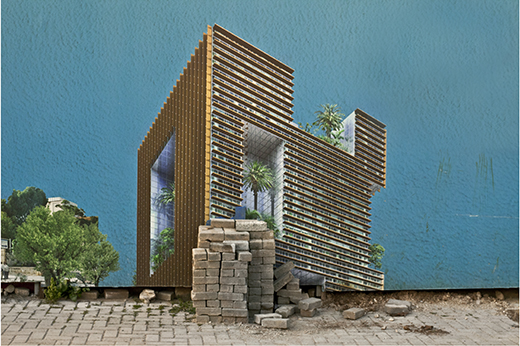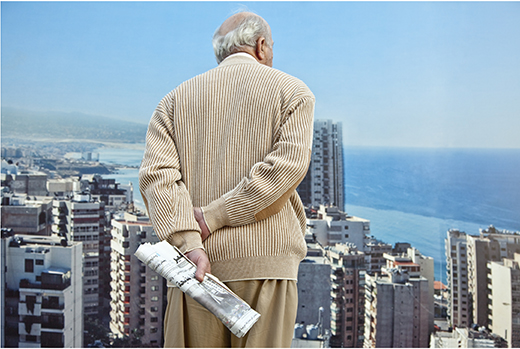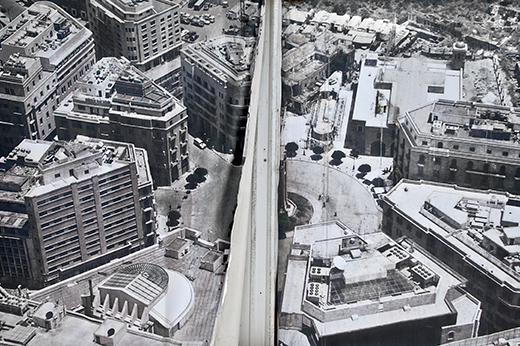Beirutopia . (2011 - ongoing)
Since the end of the Lebanese civil war in 1990, Beirut has been striving, to regain its glamour and splendor through the efforts of reconstruction, in the aim of reconstituting the old myth of a city commonly referred to as the Paris or Switzerland of the Middle East. This photography project is a portrait of Beirut’s urban future. It aims to raise questions about the devenir, or the becoming, of Beirut and its associated representations, characteristics and how they culminate to become the future essence of the city.
Beirut is currently undergoing a construction boom on the back of large inflows of foreign capital and the historical profitability of the real estate sector. To advertise construction projects, developers display large billboards in situ reproducing the proposed reality to come. These displays exemplify computerized “biopolitic” renderings that simulate the building, its interior, surroundings, illusory residents and their lifestyle.
The photography project intends to capture billboard images that represent virtual buildings framed within their real environment. This dichotomy and juxtaposition give the photographs a sense of “oddness” that reflects the current transformation of the city. The latter is demonstrated by the use of scale, layering and image framing as tools to underline readings of the city.
Beir-utopia is, in essence, the title of a counter-utopian situation, one that does not differentiate between illusory images and the pastiche narrative they embody. This confrontation allows for spaces to be redefined and their potential encouraged as new forms of identification arise and are re-appropriated within the wider social and architectural fabric of the city. The photographs become spaces of resistance.
Text by Randa Mirza and Stephanie Dadour
Beirutopia . (2011 - en cours)
BEIRUTOPIA, est une projection du portrait de l’avenir de la ville de Beyrouth. La série photographique soulève des questions sur le devenir de la capitale libanaise, à travers les caractéristiques et les représentations qu’on lui associe.
Depuis la fin de la guerre civile Libanaise en 1990, Beyrouth cherche à renouveler son mythe d’une ville glamour, à la charnière de l’Orient et de l’Occident, longtemps désigné sous la dénomination de la Suisse du Moyen-Orient. Actuellement, la ville connaît une effervescence de projets immobiliers, contrôlée par l’entrée de capitaux étrangers et une importante spéculation. Pour commercialiser les projets en construction, les développeurs placent, in situ, d’énormes panneaux publicitaires représentant le bâtiment dans sa phase finale. Ces affiches sont non seulement des simulacres mais des représentations bio-politisées, c’est-à-dire identifiant une forme de pouvoir sur la vie des gens. De manière illusoire, elles simulent, voire imposent le bâtiment, son environnement, ses intérieurs, ses habitants et leur style de vie.
Les photographies de BEIRUTOPIA sont des mises en abime de ces affiches publicitaires représentant l’immeuble virtuel, encadré depuis l’espace réel dans lequel il se trouve. Le croisement des situations virtuelle et réelle confère aux photographies un sentiment d’une inquiétante étrangeté reflétant la transformation actuelle de la ville. Cette étrangeté est valorisée par le cadrage photographique, un jeu d’échelles et de plans constituant une lecture critique du développement de la ville.
Beirut-opia est le titre d’une situation contre-utopique, ne faisant pas de distinction entre les images illusoires et les récits du pastiche qu’elle incarne. En fusionnant virtuel et réel, il s’agit de redéfinir l’espace urbain et ses potentialités, de faire émerger de nouvelles formes d’identifications et de se réapproprier le tissu social et spatial. Dans cette optique, les photographies sont un espace de résistance.
Texte de Stephanie Dadour et Randa Mirza












